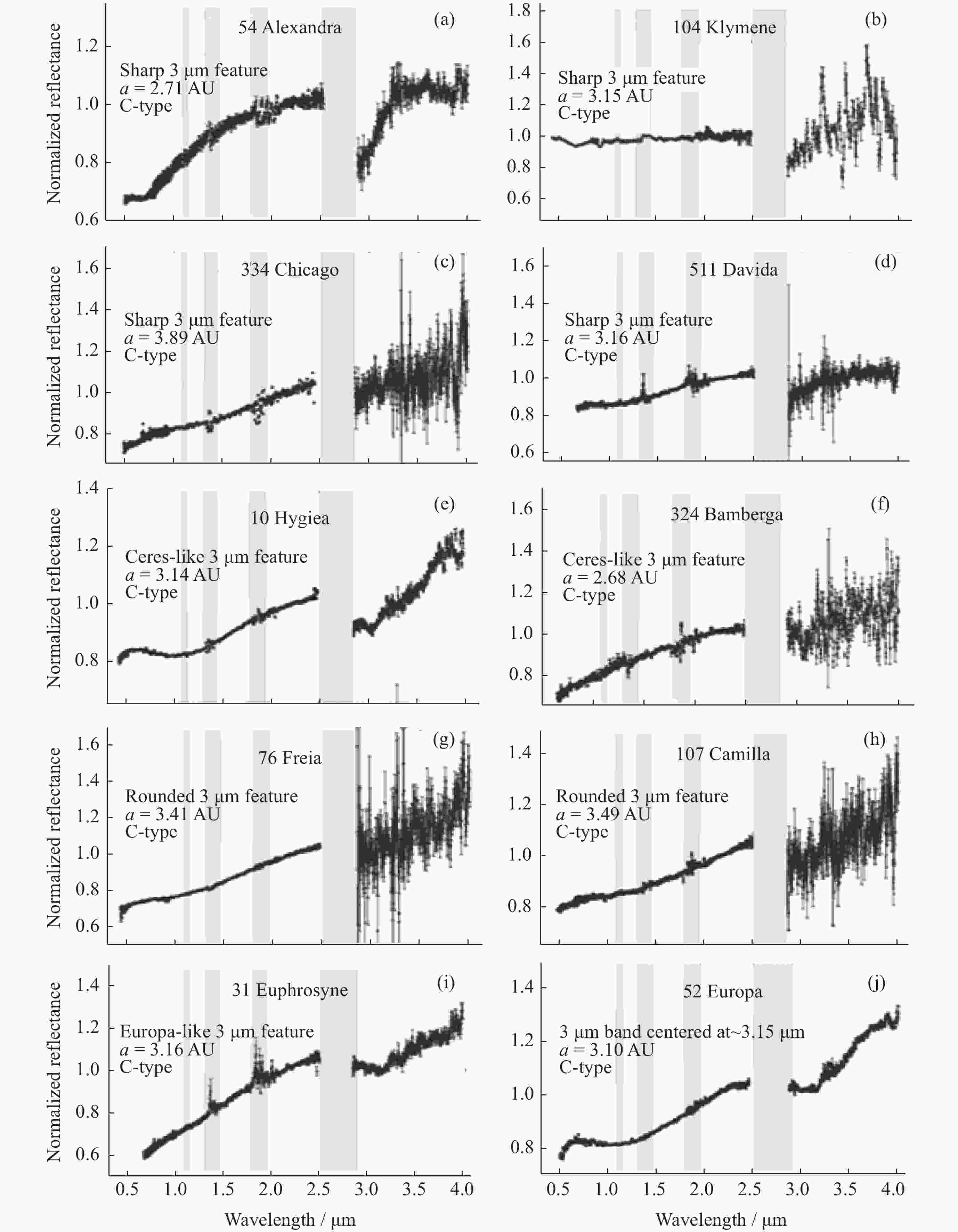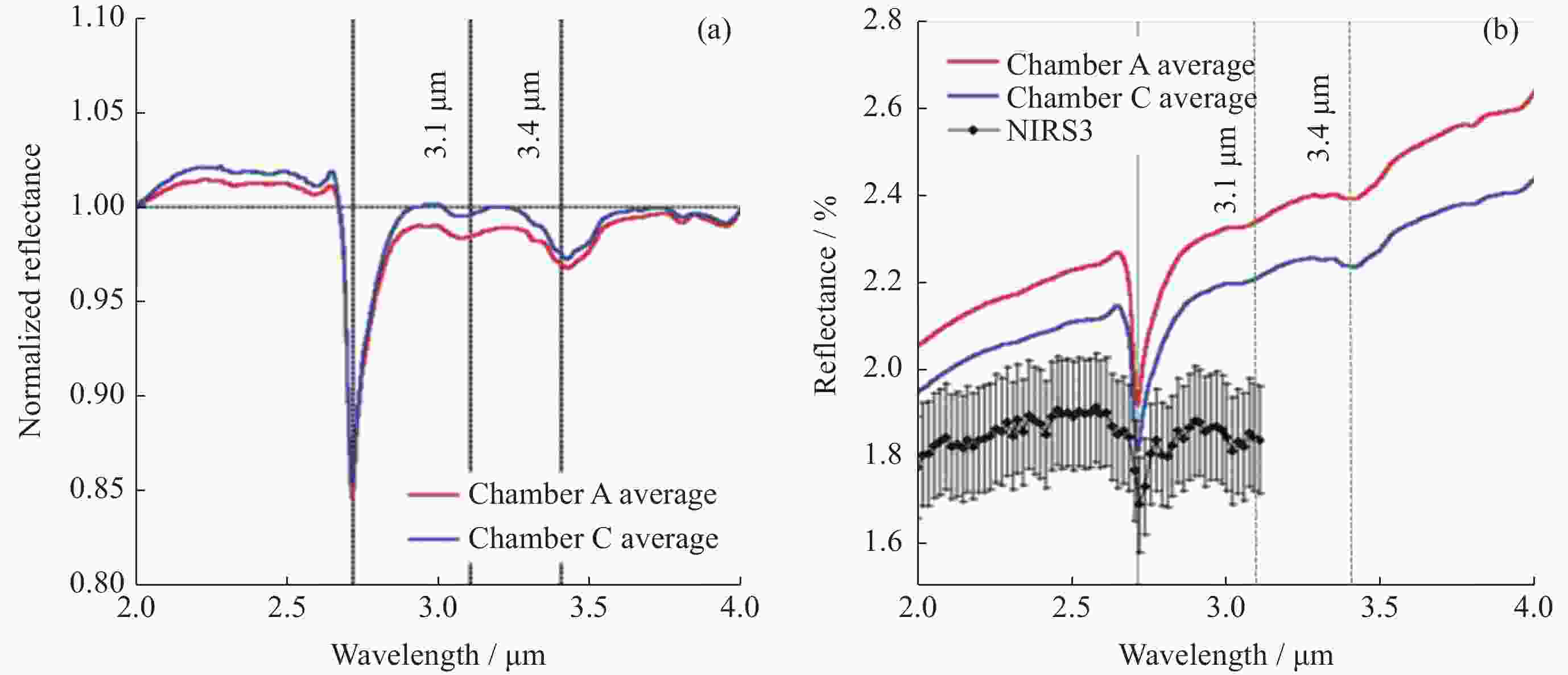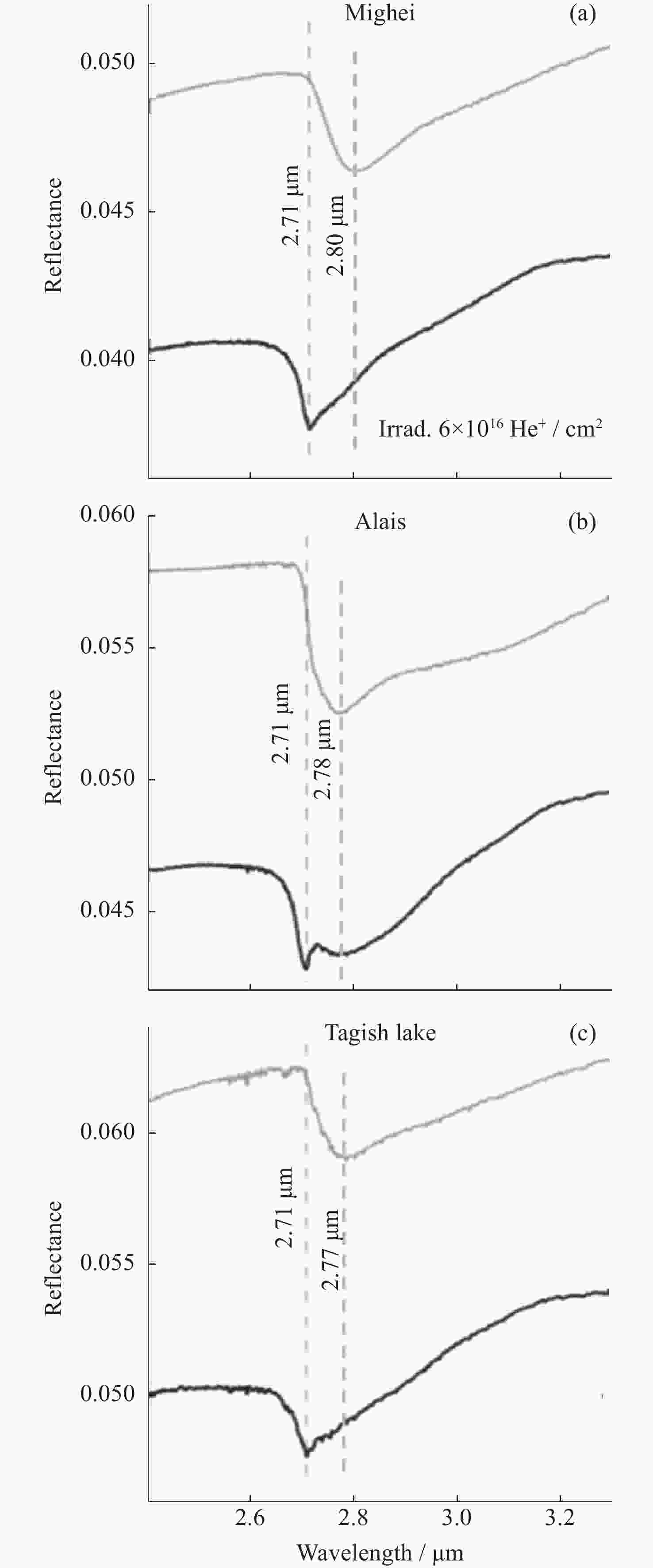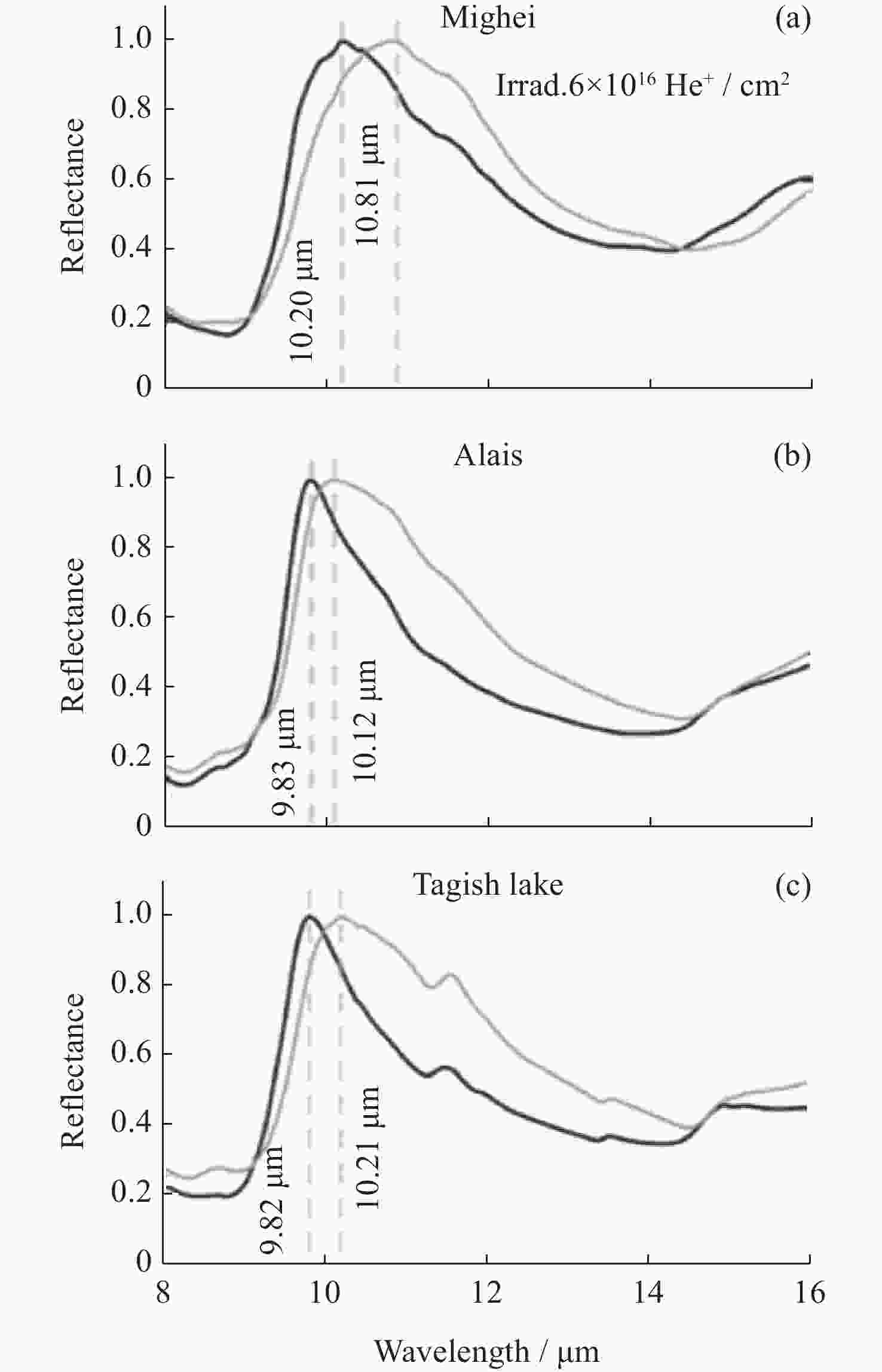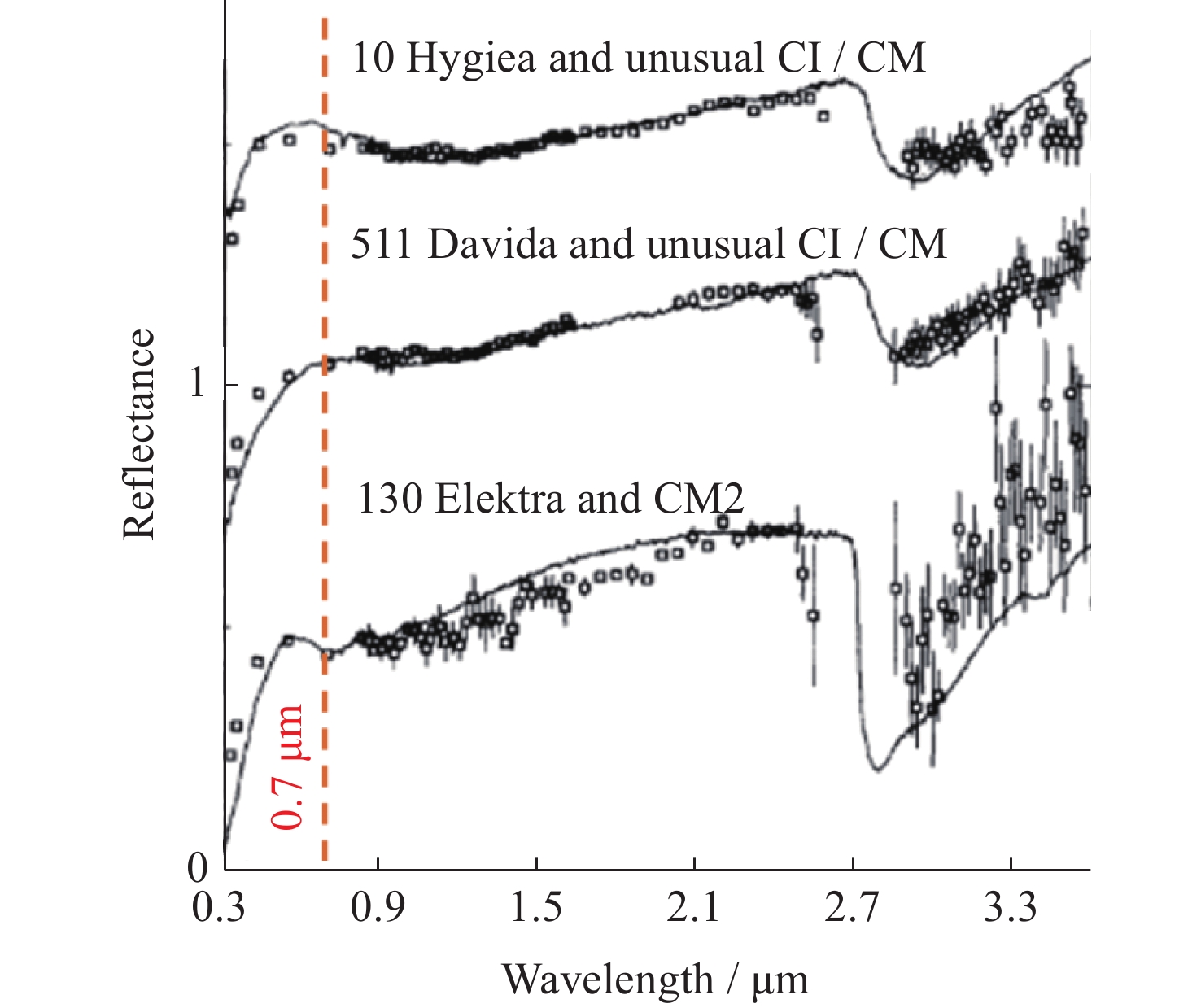Review of the Spectral Effects of Space Weathering on C-type Asteroids
-
摘要: C型小行星主要由硅酸盐矿物和含碳有机质组成,保存了太阳系形成初期的原始物质,是认识太阳系形成初期的重要物质,对研究水和生命起源与演化具有重要科学意义。目前对小行星物质组成的认识主要基于光谱特征分析,但长期的空间风化作用会改变小行星表面物质的光谱特征,所以认识小行星的物质组成需要准确厘清空间风化对光谱的影响。随着中国小行星探测工程的推进,迫切需要深入认识C型小行星的光谱特征及对空间风化的响应规律。为此,分析了C型小行星的反射率、水和有机质吸收等光谱特征以及空间风化的影响,提出研究存在的主要问题,进而指出了该研究方向的未来发展趋势和研究重点。Abstract: C-type asteroids are mainly composed of silicates and carbon-rich organic matter, which preserve the original materials of the early formation of solar system. They are important clues to understand the early formation of the solar system, and have important scientific significance for revealing the origin and evolution of water and life. At present, the understanding of the composition characteristics of asteroids is mainly based on spectral characteristics analysis. However, the long-term space weathering will change the spectral characteristics, so the understanding of the composition of asteroids needs to accurately clarify the effects of space weathering on the spectra. With the advancement of the asteroid exploration in China, it is necessary to understand the spectral characteristics and variation rules of C-type asteroids. This paper summarizes the spectral characteristics of C-type asteroids (e.g., the reflectance spectra, absorption of water and organic matter) and the influence of space weathering on C-type asteroid, analyzes the main problems existing in the research, and points out the future development trend and research focus of this research direction.
-
Key words:
- C-type asteroids /
- Spectra /
- Carbonaceous chondrites /
- Space weathering
-
表 1 C型小行星相关物理特征参数
Table 1. Physical characteristic parameters of C-type asteroids
小行星 Tholen, Bus, DeMeo分类 反照率 Ref. [19] Ref. [20] Ref. [21] Ref. [22] Ref. [23] Ref. [24] 10 Hygiea C, C, C 0.06 0.054 0.075 0.0717 0.0710 0.0579 24 Themis C, B, C - - - - - 0.0641 41 Daphne C, Ch, Ch - - 0.073 0.0828 0.0828 - 51 Nemausa C, Ch, Cgh - 0.060 0.086 0.0928 0.0928 0.0997 52 Europa CF, C, C - - 0.057 0.0578 0.0578 0.0472 54 Alexandra C, C, Cgh - - 0.050 0.0555 0.0555 0.0492 76 Freia P, X, C - - 0.029 0.0362 0.0362 0.0486 85 Io FC, B, C - - 0.068 0.0666 0.0666 0.0630 90 Antiope C, C, C - - 0.051 0.0603 0.0603 0.0569 93 Minerva CU, C, C - - 0.085 0.0881 0.0733 - 128 Nemesis C, C, C - - 0.045 0.0504 0.0504 0.0504 147 Protogeneia C, C, C - - 0.029 0.0492 0.0492 - 171 Ophelia C, C, – - - 0.054 0.0615 0.0615 0.0773 316 Goberta –, C, – - - - 0.0925 0.0925 0.0588 324 Bamberga –, C, – 0.03 0.036 - 0.0628 0.0628 0.0063 379 Huenna B, C, – - - 0.045 0.0587 0.0587 0.0654 410 Chloris C, Ch, – - - 0.054 0.0554 0.0554 0.0432 444 Gyptis C, C, C - - 0.044 0.0512 0.0490 0.0428 511 Davida C, C, – 0.06 0.060 0.053 0.0540 0.0540 0.0681 654 Zelinida C, Ch, – - - 0.043 0.0425 0.0425 0.0428 688 Melanie –, C, C - 0.040 - 0.0599 0.0599 0.5330 702 Alauda C, B, – - - 0.056 0.0587 0.0587 0.0545 814 Tauris C, C, – - - - 0.0499 0.0470 0.0444 注 小行星分类引自文献[25–27]。 表 2 C型小行星和Murchison 陨石的0.7 μm和3 μm吸收强度
Table 2. 0.7 μm and 3 μm absorption strengths of the C-type asteroids and Murchison meteorites
小行星 0.7 μm 3 μm Murchison陨石/℃ 0.7 μm 3 μm 10 Hygiea 0.0023 –0.2502 400 0.0507 –0.3070 24 Themis 0.0055 –0.0498 500 0.0457 –0.2200 31 Euphrosyne 0.0061 –0.0007 600 0.0124 –0.0275 36 Atalante 0.0147 –0.1508 700 0.0194 0.0194 51 Nemausa –0.0326 –0.4950 800 0.0064 0.0359 52 Europa –0.0010 0.0305 900 0.0524 0.0524 173 Ino 0.0028 –0.0094 1000 0.0233 0.0233 313 Chaldaea –0.1612 –0.0414 - - - 344 Desiderata 0.0153 –0.1985 - - - 386 Siegena –0.0349 –0.2614 - - - 410 Chloris –0.0093 –0.2744 - - - 511 Davida 0.0116 –0.1010 - - - 注 吸收强度计算。
0.7 μm:ln R(0.701)–[0.152 ln R(0.550)+0.151 ln R(0.853)]/0.303。
3 μm:ln R(2.9~3.0)–ln R(2.3~2.5)。表 3 太阳风注入实验模拟相关实验参数
Table 3. Experimental parameters related to solar wind injection simulation
样品 离子类型 能量/keV 最大通量/cm–2 光谱范围/μm 光谱变化 Ref. [53] Allende粉末 H+, Ar+ 40 3×1016 ion 0.4~50 变红变暗 Ref. [54] CV/CO/CM/CI/Tagish Lake/橄榄石/
辉石粉末He+ 40 6×1016 ion 0.4~16 CV/CO:变红变暗;CM/CI/Tagish Lake:变蓝变亮橄榄石/辉石:变红变暗 Ref. [55] CM MET01072薄片和CI Y 980115粉末、薄片 He+ 20 6×1016 ion 0.4~15 CM:薄片样品变亮变蓝
CI: 粉末样品变蓝变亮,而薄片样品变红,无明显变亮Ref. [57] 橄榄石粉末 He+ 4 3×1018 ion 0.66~2.5 变红变暗 Ref. [58] Murchison薄片 He+ 4 1×1018 ion 2.4~3.8 变红变暗 Ref. [59] Murchison粉末 Ar+, He+ 40 3×1016 ion 0.4~16 Ar+:粉末样品变红变亮
He+:粉末样品变红变暗Ref. [60] Murchison薄片 H+, He+ 1,4 1.1×1018 He+
8.1×1017 H+0.35~2.50 变亮变红 Ref. [61] Allende和Murchison粉末 Ar+, He+ 40 3×1016 ion 2.5~12 变红 Ref. [62] 蛇纹石和皂石粉末 H+ 10 1.7×1018 ion 1.5~5 蛇纹石:变蓝
皂石:变红Ref. [70] 天然沥青粉末 H+, Ar+, N+, He+ 15~400 7.4×1015 H+
6.2×1015 N+
8×1015 Ar+
2.5×1016 He+0.3~2.5 变蓝变亮 表 4 微陨石轰击实验模拟相关实验参数
Table 4. Experimental parameters related to micrometeorite bombardment simulation
文献 样品 脉冲持续时间 辐照激光能量/mJ 光谱范围/μm 光谱变化 Ref. [65] Murchison粉末 6~8 ns
5~7 ns0, 5, 10,15 0.25~14 变蓝变暗 Ref. [66] Allende粉末 6000~12000次 30 0.4~0.5 变蓝 Murchison粉末 48000次 30 0.35~2.5 变暗 石墨粉末 48000次 30 0.35~2.5 无明显变化 Ref. [67] Murchison粉末 N/A 0.7, 1, 2, 5 0.25~14 变蓝变暗 Ref. [68] NWA 3118, Allende粉末 5~7 ns, 40 min 30 0.35~2.5 变红变暗 Ref. [69] Murchison粉末 6~8 ns 0~15 0.25~14 变蓝变暗 Ref. [71] Murchison薄片 6~8 ns 48 0.35~2.5 变蓝变暗 Ref. [72] CI和CM陨石模拟样品 6~8 ns 3.5 0.25~0.9
0.75~2.5变蓝变暗 Ref. [74] Murchison薄片 6~8 ns 48 0.35~2.5 变蓝变暗 Ref. [75] Murchison薄片 6~8 ns 48 0.35~14.3 变蓝变暗 -
[1] YADA T, ABE M, OKADA T, et al. Ryugu: a brand-new planetary sample returned from a C-type asteroid[Z]. Nature Portfolio, 2021, 1-20. DOI: 10.21203/rs.3.rs-608561/v1 [2] ZELLNER B, THOLEN D J, TEDESCO E F. The eight-color asteroid survey: results for 589 minor planets[J]. Icarus, 1985, 61(3): 355-416 doi: 10.1016/0019-1035(85)90133-2 [3] THOLEN D J. Asteroid taxonomic classifications[M]//BINZEL R P, GEHRELS T, SHAPLEY MATTHEWS M. Asteroids II. Tucson: University. of Arizona Press, 1989 [4] BUS S J, BINZEL R P. Phase II of the small main-belt asteroid spectroscopic survey: a feature-based taxonomy[J]. Icarus, 2002, 158(1): 146-177 doi: 10.1006/icar.2002.6856 [5] DEMEO F E, BINZEL R P, SLIVAN S M, et al. An extension of the Bus asteroid taxonomy into the near-infrared[J]. Icarus, 2009, 202(1): 160-180 doi: 10.1016/j.icarus.2009.02.005 [6] BUSAREV V V. A hypothesis on the origin of C-type asteroids and carbonaceous chondrites[OL]. arXiv preprint arXiv: 1211.3042, 2012 [7] GAFFEY M J, MCCORD T B. Asteroid surface materials: mineralogical characterizations from reflectance spectra[J]. Space Science Reviews, 1978, 21(5): 555-628 [8] DE SANCTIS M C, AMMANNITO E, RAPONI A, et al. Ammoniated phyllosilicates with a likely outer Solar System origin on (1) Ceres[J]. Nature, 2015, 528(7581): 241-244 doi: 10.1038/nature16172 [9] MATSUOKA M, NAKAMURA T, HIROI T, et al. Infrared spectra of asteroid Ryugu: comparison to laboratory-measured carbonaceous chondrites[C]//Proceedings of the 50 th Annual Lunar and Planetary Science Conference. Texas: LPI Contribution No. 2132, 2019: 1534 [10] CAMPINS H, HARGROVE K, PINILLA-ALONSO N, et al. Water ice and organics on the surface of the asteroid 24 Themis[J]. Nature, 2010, 464(7293): 1320-1321 doi: 10.1038/nature09029 [11] PILORGET C, OKADA T, HAMM V, et al. First compositional analysis of Ryugu samples by the MicrOmega hyperspectral microscope[J]. Nature Astronomy, 2022, 6(2): 221-225 [12] PIETERS C M, NOBLE S K. Space weathering on airless bodies[J]. Journal of Geophysical Research:Planets, 2016, 121(10): 1865-1884 doi: 10.1002/2016JE005128 [13] TRANG D, THOMPSON M S, CLARK B E, et al. The role of hydrated minerals and space weathering products in the bluing of carbonaceous asteroids[J]. The Planetary Science Journal, 2021, 2(2): 68 doi: 10.3847/PSJ/abe76f [14] MALFAVON A. Space Weathering Simulation Trends on Carbonaceous Chondrites[D]. Central Florida: University of Central Florida, 2020 [15] HENDRIX A R, VILAS F. C‐complex asteroids: UV‐visible spectral characteristics and implications for space weathering effects[J]. Geophysical Research Letters, 2019, 46(24): 14307-14317 doi: 10.1029/2019GL085883 [16] REUTER D C, SIMON A A, HAIR J, et al. The OSIRIS-REx visible and InfraRed spectrometer (OVIRS): spectral maps of the asteroid bennu[J]. Space Science Reviews, 2018, 214(2): 54 doi: 10.1007/s11214-018-0482-9 [17] 中国国家航天局. 小行星探测任务有效载荷和搭载项目机遇公告[EB/OL]. [ 2019-04-19] http://www.cnsa.gov.cn/n6758823/n6758839/c6805886/content.htmlChina National Space Administration. Asteroid mission payload and carrying project opportunity announcement [EB/OL]. [2019-04-19] http://www.cnsa.gov.cn/n6758823/n6758839/c6805886/content.html [18] SHARKEY B N L, REDDY V, MALHOTRA R, et al. Lunar-like silicate material forms the Earth quasi-satellite (469219) 2016 HO3 Kamoʻoalewa[J]. Communications Earth & Environment, 2021, 2(1): 231 [19] MORRISON D. Radiometric diameters and albedos of 40 asteroids[J]. Astrophysical Journal, 1974, 194(15): 203-212 [20] CHAPMAN C R, MORRISON D, ZELLNER B. Surface properties of asteroids: a synthesis of polarimetry, radiometry, and spectrophotometry[J]. Icarus, 1975, 25(1): 104-130 doi: 10.1016/0019-1035(75)90191-8 [21] TEDESCO E F, WILLIAMS J G, MATSON D L, et al. A three-parameter asteroid taxonomy[J]. Astronomical Journal, 1989, 97: 580-606 doi: 10.1086/115007 [22] TEDESCO E F. The IRAS minor planet survey[R]. Cambridge University Press, 1994, 1-437 [23] TEDESCO E F, NOAH P V, NOAH M, et al. The supplemental IRAS minor planet survey[J]. The Astronomical Journal, 2002, 123(2): 1056-1085 doi: 10.1086/338320 [24] MASIERO J R, MAINZER A K, GRAV T, et al. Main belt asteroids with WISE/NEOWISE. I. Preliminary albedos and diameters[J]. The Astrophysical Journal, 2011, 741(2): 68 doi: 10.1088/0004-637X/741/2/68 [25] TEDESCO E F, EGAN M P, PRICE S D. The midcourse space experiment infrared minor planet survey[J]. The Astronomical Journal, 2002, 124(1): 583 [26] TEDESCO E F. Archiving asteroid photometric data[J]. Highlights of Astronomy, 1992, 9: 719-720 doi: 10.1017/S1539299600010169 [27] THOLEN D J. Asteroid Taxonomy from Cluster Analysis of Photometry[D]. Tucson: The University of Arizona, 1984 [28] 唐红, 李雄耀, 王世杰. 不同赋存状态水的光谱特征分析[C]//中国矿物岩石地球化学学会第14届学术年会论文摘要专辑. 南京: 《高校地质学报》编辑部, 2013TANG Hong, LI Xiongyao, WANG Shijie. Analysis of spectral characteristics of water in different occurrence states[C]//Proceedings of the Abstract Album of the 14 th Annual Conference of Chinese Society of Mineralogy, Petrology and Geochemistry. Nanjing: Editorial Department of Journal of University Geology, 2013 [29] BECK P, ESCHRIG J, POTIN S, et al. “Water” abundance at the surface of C-complex main-belt asteroids[J]. Icarus, 2021, 357: 114125 doi: 10.1016/j.icarus.2020.114125 [30] LEBOFSKY L A. Infrared reflectance spectra of asteroids: a search for water of hydration[J]. The Astronomical Journal, 1980, 85: 573-585 doi: 10.1086/112714 [31] BARUCCI M A, DOTTO E, BRUCATO J R, et al. 10 Hygiea: ISO infrared observations[J]. Icarus, 2002, 156(1): 202-210 doi: 10.1006/icar.2001.6775 [32] BARUCCI M A, DORESSOUNDIRAM A, FULCHIGNONI M, et al. Search for aqueously altered materials on asteroids[J]. Icarus, 1998, 132(2): 388-396 doi: 10.1006/icar.1998.5889 [33] VILAS F. A cheaper, faster, better way to detect water of hydration on Solar System bodies[J]. Icarus, 1994, 111(2): 456-467 doi: 10.1006/icar.1994.1156 [34] HOWELL E S, RIVKIN A S, SODERBERG A, et al. Aqueous alteration of asteroids: correlation of the 3 μm and 0.7 μm hydration bands[C]//Proceedings of the 31 st DPS Meeting. Padova: American Astronomical Society, 1999: 1074 [35] VILAS F, GAFFEY M J. Phyllosilicate absorption features in main-belt and outer-belt asteroid reflectance spectra[J]. Science, 1989, 246(4931): 790-792 doi: 10.1126/science.246.4931.790 [36] HIROI T, ZOLENSKY M E, PIETERS C M, et al. Thermal metamorphism of the C, G, B, and F asteroids seen from the 0.7 μm, 3 μm, and UV absorption strengths in comparison with carbonaceous chondrites[J]. Meteoritics & Planetary Science, 1996, 31(3): 321-327 [37] FORNASIER S, LANTZ C, BARUCCI M A, et al. Aqueous alteration on main belt primitive asteroids: results from visible spectroscopy[J]. Icarus, 2014, 233: 163-178 doi: 10.1016/j.icarus.2014.01.040 [38] TAKIR D, EMERY J P. Outer main belt asteroids: identification and distribution of four 3-μm spectral groups[J]. Icarus, 2012, 219(2): 641-654 doi: 10.1016/j.icarus.2012.02.022 [39] KAMEDA S, YOKOTA Y, KOUYAMA T, et al. Improved method of hydrous mineral detection by latitudinal distribution of 0.7-μm surface reflectance absorption on the asteroid Ryugu[J]. Icarus, 2021, 360: 114348 doi: 10.1016/j.icarus.2021.114348 [40] KITAZATO K, MILLIKEN R E, IWATA T, et al. The surface composition of asteroid 162173 Ryugu from Hayabusa2 near-infrared spectroscopy[J]. Science, 2019, 364(6437): 272-275 doi: 10.1126/science.aav7432 [41] GERMANN J T, FIEBER-BEYER S K, GAFFEY M J. Evidence for hydrated minerals in the VNIR spectra of G-class asteroids: a first look[J]. Icarus, 2022, 377: 114916 doi: 10.1016/j.icarus.2022.114916 [42] LEBOFSKY L A. Asteroid 1 Ceres: evidence for water of hydration[J]. Monthly Notices of the Royal Astronomical Society, 1978, 182(1): 17P-21P doi: 10.1093/mnras/182.1.17P [43] JONES T D, LEBOFSKY L A, LEWIS J S, et al. The composition and origin of the C, P, and D asteroids: water as a tracer of thermal evolution in the outer belt[J]. Icarus, 1990, 88(1): 172-192 doi: 10.1016/0019-1035(90)90184-B [44] RIVKIN A S, HOWELL E S, VILAS F, et al. Hydrated Minerals on Asteroids: the Astronomical Record[R]. Tucson: Asteroids III, 2002: 235-253 [45] CRUIKSHANK D P, BROWN R H. Organic matter on asteroid 130 Elektra[J]. Science, 1987, 238(4824): 183-184 doi: 10.1126/science.238.4824.183 [46] RIVKIN A S, EMERY J P. Detection of ice and organics on an asteroidal surface[J]. Nature, 2010, 464(7293): 1322-1323 doi: 10.1038/nature09028 [47] RIVKIN A S, HOWELL E S, EMERY J P. Infrared spectroscopy of large, low‐albedo asteroids: are Ceres and Themis archetypes or outliers?[J]. Journal of Geophysical Research: Planets, 2019, 124(5): 1393-1409 doi: 10.1029/2018JE005833 [48] YADA T, ABE M, OKADA T, et al. Preliminary analysis of the Hayabusa2 samples returned from C-type asteroid Ryugu[J]. Nature Astronomy, 2022, 6(2): 214-220 [49] PARKER E T, FURUSHO A, GLAVIN D P, et al. Amino acid analyses of a sample of Ryugu by a combination of liquid chromatograhpy and high-resolution mass spectrometry techniques[C]//Proceedings of the 53 rd Lunar and Planetary Science Conference. Texas: LPI Contribution No. 2678, 2022: 2651 [50] APONTE J C, DWORKIN J P, GLAVIN D P, et al. Two-dimensional gas chromatography analysis of Ryugu samples[C]//Proceedings of the 53 rd Lunar and Planetary Science Conference. Texas: LPI Contribution No. 2678, 2022: 1221 [51] HASHIGUCHI M, AOKI D, FUKUSHIMA K, et al. The spatial distribution of soluble organic matter and their relationship to minerals in the asteroid (162173) Ryugu[J]. Earth, Planets and Space, 2023, 75(1): 73 doi: 10.1186/s40623-023-01792-w [52] MOROZ L, BARATTA G, STRAZZULLA G, et al. Optical alteration of complex organics induced by ion irradiation: : 1. Laboratory experiments suggest unusual space weathering trend[J]. Icarus, 2004, 170(1): 214-228 doi: 10.1016/j.icarus.2004.02.003 [53] BRUNETTO R, LANTZ C, LEDU D, et al. Ion irradiation of Allende meteorite probed by visible, IR, and Raman spectroscopies[J]. Icarus, 2014, 237: 278-292 doi: 10.1016/j.icarus.2014.04.047 [54] LANTZ C, BRUNETTO R, BARUCCI M A, et al. Ion irradiation of carbonaceous chondrites: a new view of space weathering on primitive asteroids[J]. Icarus, 2017, 285: 43-57 doi: 10.1016/j.icarus.2016.12.019 [55] NAKAMURA T, LANTZ C, KOBAYASHI S, et al. Experimental reproduction of space weathering of C-type asteroids by He exposure to shocked and partially dehydrated carbonaceous chondrites[C]//Proceedings of the the 82 nd Annual Meeting of the Meteoritical Society. Sapporo: LPI Contribution No. 2157, 2019: 6211 [56] LAGERKVIST C I, MOROZ L, NATHUES A, et al. A study of Cybele asteroids-II. Spectral properties of Cybele asteroids[J]. Astronomy & Astrophysics, 2005, 432(1): 349-354 [57] LOEFFLER M J, DUKES C A, BARAGIOLA R A. Irradiation of olivine by 4 keV He+: simulation of space weathering by the solar wind[J]. Journal of Geophysical Research: Planets, 2009, 114(E3): E03003 [58] KELLER L P, CHRISTOFFERSEN R, DUKES C A, et al. Ion irradiation experiments on the Murchison CM2 carbonaceous chondrite: simulating space weathering of primitive asteroids[C]//Proceedings of the 46 th Lunar and Planetary Science Conference. Texas: LPI Contribution No. 1832, 2015: 1913 [59] LANTZ C, BRUNETTO R, BARUCCI M A, et al. Ion irradiation of the Murchison meteorite: visible to mid-infrared spectroscopic results[J]. Astronomy & Astrophysics, 2015, 577: A41 [60] LACZNIAK D L, THOMPSON M S, CHRISTOFFERSEN R, et al. Understanding space weathering of carbonaceous asteroids through H+ and He+ ion irradiation of the Murchison meteorite[C]//Proceedings of the 52 nd Lunar and Planetary Science Conference. Texas: LPI Contribution No. 2548, 2021: 2548 [61] BRUNETTO R, LANTZ C, DIONNET Z, et al. Hyperspectral FTIR imaging of irradiated carbonaceous meteorites[J]. Planetary and Space Science, 2018, 158: 38-45 doi: 10.1016/j.pss.2018.05.008 [62] NAKAUCHI Y, ABE M, OHTAKE M, et al. The formation of H2O and Si-OH by H2+ irradiation in major minerals of carbonaceous chondrites[J]. Icarus, 2021, 355: 114140 doi: 10.1016/j.icarus.2020.114140 [63] ORTHOUS-DAUNAY F R, ISA J, WOLTERS C, et al. Molecular growth pattern of soluble CHN compounds from Ryugu[C]//Proceedings of the 53 rd Lunar and Planetary Science Conference. Texas: LPI Contribution No. 2678, 2022: 2367 [64] REMUSAT L, VERDIER-PAOLETTI M, MOSTEFAOUI S, et al. H-and N-isotope distributions in the insoluble organic matter of Ryugu samples[C]//Proceedings of the 53 rd Lunar and Planetary Science Conference. Texas: LPI Contribution No. 2678, 2022: 1448 [65] MATSUOKA M, NAKAMURA T, KIMURA Y, et al. Pulse-laser irradiation experiments of Murchison CM2 chondrite for reproducing space weathering on C-type asteroids[J]. Icarus, 2015, 254: 135-143 doi: 10.1016/j.icarus.2015.02.029 [66] GILLIS-DAVIS J J, GASDA P J, BRADLEY J P, et al. Laser space weathering of Allende (CV2) and Murchison (CM2) carbonaceous chondrites[C]// 46 th Lunar and Planetary Science Conference. Texas: LPI Contribution No. 1832, 2015: 1607 [67] MATSUOKA M, NAKAMURA T, KIMURA Y, et al. Reproducing space weathering on C-Type asteroids with low-energy laser irradiation experiments of the Murchison meteorite[C]//Proceedings of the 47 th Annual Lunar and Planetary Science Conference. Texas: LPI Contribution No. 1903, 2016: 1823 [68] GILLIS-DAVIS J J, ISHII H A, ADAMS M, et al. Laser irradiation of two CV3 meteorites yields desparate weathering effects[C]//Proceedings of the 48 th Annual Lunar and Planetary Science Conference. Texas: LPI Contribution No. 1964, 2017: 1003 [69] MATSUOKA M, NAKAMURA T, HIROI T, et al. Space weathering simulation with low-energy laser irradiation of Murchison CM chondrite for reproducing micrometeoroid bombardments on C-type asteroids[J]. The Astrophysical Journal Letters, 2020, 890(2): L23 doi: 10.3847/2041-8213/ab72a4 [70] MOROZ L V, HIROI T, SHINGAREVA T V, et al. Reflectance spectra of CM2 chondrite Mighei irradiated with pulsed laser and implications for low-albedo asteroids and Martian moons[C]//Proceedings of the 35 th Lunar and Planetary Science Conference. Texas: abstract No. 1279, 2004 [71] THOMPSON M S, LOEFFLER M J, MORRIS R V, et al. Spectral and chemical effects of simulated space weathering of the Murchison CM2 carbonaceous chondrite[J]. Icarus, 2019, 319: 499-511 doi: 10.1016/j.icarus.2018.09.022 [72] PRINCE B S, LOEFFLER M J. Space weathering of the 3-μm phyllosilicate feature induced by pulsed laser irradiation[J]. Icarus, 2022, 372: 114736 doi: 10.1016/j.icarus.2021.114736 [73] BUSEMANN H, ALEXANDER C M O D, NITTLER L R. Characterization of insoluble organic matter in primitive meteorites by microRaman spectroscopy[J]. Meteoritics & Planetary Science, 2007, 42(7/8): 1387-1416 [74] THOMPSON M S, LOEFFLER M J, MORRIS R V, et al. Investigating the effects of simulated micrometeorite impacts on a carbonaceous chondrite through coordinated analysis[C]//Proceedings of the 82 nd Annual Meeting of the Meteoritical Society. Sapporo: LPI Contribution No. 2157, 2019: 6318 [75] THOMPSON M S, MORRIS R V, CLEMETT S J, et al. The effect of progressive space weathering on the organic and inorganic components of a carbonaceous chondrite[J]. Icarus, 2020, 346: 113775 doi: 10.1016/j.icarus.2020.113775 -
-





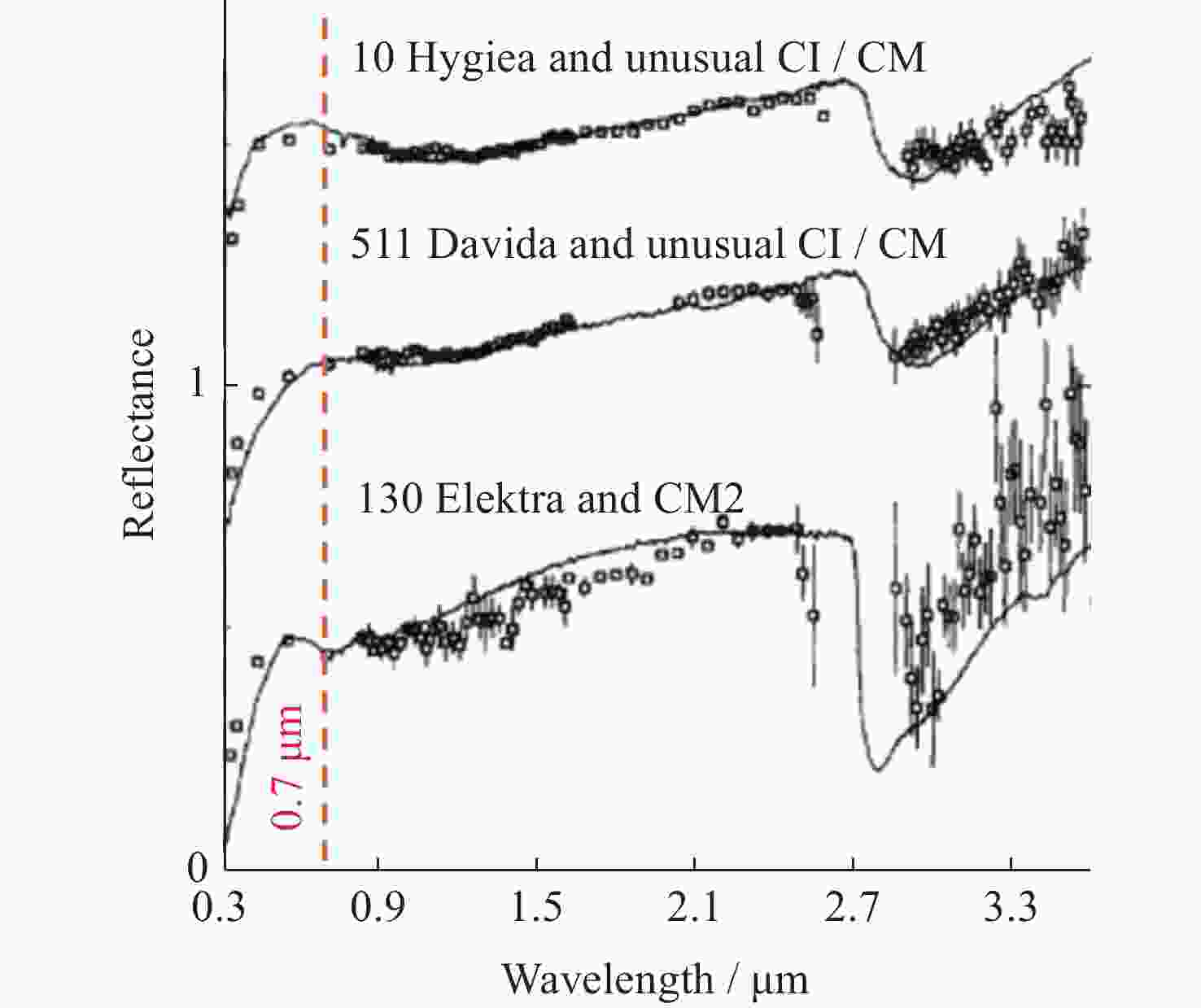
 下载:
下载:
